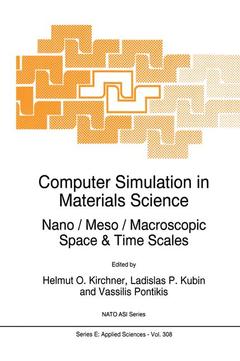Description
Computer Simulation in Materials Science, Softcover reprint of the original 1st ed. 1996
Nano / Meso / Macroscopic Space & Time Scales
NATO Science Series E: Series, Vol. 308
Coordinators: Kirchner H.O., Kubin Ladislas P., Pontikis Vassilis
Language: English
Keywords
Publication date: 10-2011
604 p. · 16x24 cm · Paperback
604 p. · 16x24 cm · Paperback
Description
/li>Contents
/li>
This volume collects the contributions to the NATO Advanced Study Institute (ASI); "Computer Simulation in Materials Science -NanolMesolMacroscopic Space and Time Scales", held on lIe d'OIeron (France) June 6-16, 1995.1his event was intended to present the state of the art in simulation techniques in Materials Science. For decades to come the limits of computing power will not allow for atomistic simulations of macroscopic specimens. Simulations can only be performed on various scales (nano, meso, micro, macro) with the constitutive input provided by simulations (or data) on the next smaller scale. The resulting hierarchy has been the main topic of many of lectures and seminars. Necessarily, special emphasis was placed on mesoscopic simulations bridging the gaps between nano (atomic) and micro space and time scales. During the ASI, lecturers and participants did not only consider fundamental problems, but also applications. Papers on the evolution of morphological patterns in phase transformations and plastic deformation, irradiation effects, mass transport and mechanical properties of materials in general, highlighted what has already been achieved. It was concluded that computer simulations must be based on realistic and efficient models, the fundamental equations controlling the dynamical evolution of microstructures, stochastic field kinetic models being a case in point.
1. Space and Time Scales.- Space and Time Scales during the Development of Microstructures in the Solide State.- Balance and Flow Laws at Different Scales.- Length and Time Scales in Materials Science: Interfacial Pattern Formation.- 2. Simulation Techniques at Different Scales.- Atomistic Simulations.- Cellular Automata and Mesoscale Simulations.- Meso-Macro Modelling using the Finite Element Method.- Parallelism: Overview of an Evolution.- 3. Modelling and Applications: Atomic Scale.- The Microscopic World of Atomic Diffusion: Dynamical Simulations as a Tool to probe the Temporal Evolution of Complex Systems.- Structure and Morphology of Solid Surfaces.- Simulation of Interfaces at the Atomic Scale.- Defect Production in Irradiated Metals: Insight from Computer Simulation.- A Parallel Molecular Dynamics Investigation of Fracture.- Atomistic Modeling of Failure Mechanisms.- 4. Modelling and Applications: Mesoscopic Scale.- Application of Cellular Automata in Materials Science.- A Lattice-Gas Model for a Reaction-Diffusion System.- Dislocation Patterns.- Dislocations and the Meso-Macro Connection.- Meso-Scale Simulation of the Dislocation Dynamics.- Modeling of Dynamical Evolution of Micro/Mesoscopic Morphological Patterns in Coherent Phase Transformations.- Mesoscopic Simulations of Recrystallization.- Simulation of TEM Dislocation Contrasts.- 5. Modelling and Applications: Macroscopic Scale.- Modelling the Brittle to Ductile Transition in Single Crystals.- Trends for Numerical Modellings in Stress Corrosion Cracking and Corrosion Fatigue Damage.- Micro-Macro Modeling.- The Meso-Macro Connection in Polycrystals.- Meso-Macro Connection based on Morphological Analysis: Foundations, Merits and Drawbacks.- The Analysis of Localized Plastic Flow.- Modelling of ManufacturingProcesses: A Material Science Perspective.- List of Participants.- Author Index.
© 2024 LAVOISIER S.A.S.
These books may interest you

Mechanics Over Micro and Nano Scales 158.24 €

BioceramicsFrom Macro to Nanoscale 258.68 €


